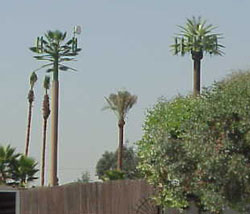Cell Phone Antenna Links
Cell Phone Antenna Links
Antennas are a key technology in a cellular phone system or any other wireless system. In a wireless system, an antenna converts guided radio wave energy (such as a signal traveling in a coaxial cable for television) to energy that is emitted or “radiated” out into free space. An antenna also does the reverse—it receives radio waves from the air and feeds them into the devices that detect, decode, and amplify them. In a cell phone system, there is one antenna in the handset and another in the base station tower. Both of these antennas transmit and receive waves.
Base station antennas are the long, narrow rectangular devices, usually in groups of three, mounted high on a base station tower. The base station can be thought of as the “command center” that both sends and receives signals to the consumer’s hand set. The base station performs a “router” function to properly direct incoming and outgoing calls, and a “repeater” function to enable the consumer to communicate from cell to cell within the terrestrial cellular network. The base station antenna is mounted on tall towers because from this high point it is easier to stay in communication with cell phone users, who are often near the ground.
When designing cellular phone antennas, especially the ones for the base stations, engineers have to balance several different needs and concerns. The first is “directionality.” All transmitting antennas radiate energy in a particular pattern that depends on the shape of the antenna and other factors. It is best for a cellular system if that pattern is roughly parallel to the ground, where most cell phone users are located. Another important concern is called “gain,” which refers to the fact that an antenna does not transmit (or receive) waves from every direction with equal sensitivity. A third factor is physical size. Because antennas have to be placed along roads and in other public places, they cannot be too tall or too large. Engineers have to find compromises that take into account these and other factors to design antennas that work well.
A cellular handset antenna is the small cylindrical stub sticking out of the top of the hand set case. In some cases antennas are embedded in the handset case and are not visible to the user. Cell phone handset antennas pose a different set of problems than the base stations. Since a cell phone user is constantly changing his or her position and moving from cell to cell, the mobile phone requires an antenna that transmits and receives equally well in all directions. Unfortunately, an antenna of this type is always less sensitive than one optimized to transmit or receive in a narrow beam. Engineers must design the antenna so that it provides both good mobility and good voice quality.
Another major concern in cellular antenna design is the potential radiation hazards posed to humans. As the use of cell phones increases, there are growing concerns about what affect the cell phone’s radio waves have on human health. Various antenna designs have been promoted to minimize the amount of energy that is radiated into the skull of the user.

